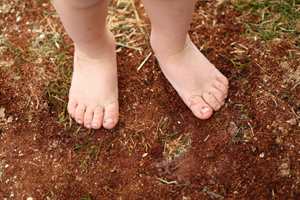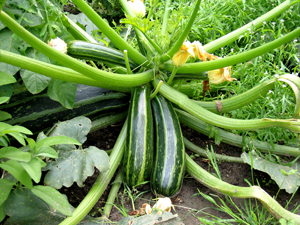Proof you can have fun around the office. We got a special visit from WCAX on April 1 and we’re featured in a very popular video where we debuted our newest product.
Udderly The Best!™ Compost Made in Vermont
Proof you can have fun around the office. We got a special visit from WCAX on April 1 and we’re featured in a very popular video where we debuted our newest product.
 Your organic garden is in full swing in August, and you probably have more fruits and vegetables than you know what to do with, partially thanks to using organic garden compost such as MOO PLUS® , MOO PLANT™ , and MOO GROW® .
Your organic garden is in full swing in August, and you probably have more fruits and vegetables than you know what to do with, partially thanks to using organic garden compost such as MOO PLUS® , MOO PLANT™ , and MOO GROW® .
Following are five of the top garden jobs for the month of August.
The best job: pick and eat!
Depending on when you planted, you should have plenty of fruits and veggies to eat and store. If you have a large garden, harvesting may be a daunting prospect in August, but you need to pick consistently to ensure you have fresh food and that the plants keep producing for a little longer.
Decide what to do with all this food!
You may grow just the right amount for your family, or you may have a surplus of food. You’ll need to decide what to do with the extra fruit and vegetables. You may decide to can, freeze, give away, or turn it into other food such as salsa, spaghetti sauce, or relish. This in itself can be a big job.
Stay on top of pest control, weeding, watering, and the compost pile.
Doing these tasks on a consistent basis helped create the bountiful garden you have now, so keep on doing them through August. Turn the compost, water as needed, weed regularly, and keep an eye out for little critters.
If you have bigger critters who want to share your crops, consider spreading mothballs or used kitty litter, putting up a fence, or placing fox or wolf urine around the perimeter of your organic garden.
Replace or add strawberry plants.
Now is a good time to replace any plants that are older than 4 years, or add more if you have room. You can buy new or use runners from your current plants. Don’t forget to use an organic soil amendment like MOO DOO® when you plant.
At the end of the month, start thinking about putting the garden to bed.
Although you may not do it for another couple of months, begin thinking about when to stop harvesting and getting the garden ready for winter. It might be easier to gradually let it go instead of stopping it all at once. Plan your exit strategy.
This is the most efficient time to apply soil amendments like MOO DOO® or MOO PLUS®. Once the garden in pulled, till in a large amount of DOO or PLUS and let it do the work for you as the nitrogen will slowly release into the soil to benefit your garden.
 In July, you start to see the payoff for all the hard work you’ve done. You’ll also start to see why using MOO DOO®, MOO DIRT®, or MOO PLUS® was a good idea! As well as harvesting your bounty, you’ll have plenty of other things to do in your organic garden in July.
In July, you start to see the payoff for all the hard work you’ve done. You’ll also start to see why using MOO DOO®, MOO DIRT®, or MOO PLUS® was a good idea! As well as harvesting your bounty, you’ll have plenty of other things to do in your organic garden in July.
Enjoy the fruits (and vegetables) of your labor.
You should have plenty of greens to harvest in July, so reap what you’ve sown. If you need to replant, do it now so you’ll have at least one more harvest. For many plants, the more you pick, the more you’ll get, so start plucking.
Don’t forget to weed and water.
While you’re having so much fun harvesting, making relish and salsa, and freezing your food, it’s easy to forget (or avoid) the not-so-fun stuff like weeding and watering. Be sure to stay on top of it, even if you don’t feel like it, so you don’t have a massive weeding job later. Don’t slack on the watering now, or your plants will slow down and not yield as much as they could. But don’t over-water either. It is a delicate balance.
Be on the lookout for pests.
As the temperature climbs, so do the insect populations. If you haven’t already, attract anything that eats insects to your garden. Put up a birdbath (or three), consider buying some ladybugs or lacewings, or sprinkle some diatomaceous earth around your plants to kill insects.
Thin plants as necessary.
Don’t allow your garden to become or stay overcrowded. Thin your crops and replant elsewhere if you can.
Organic gardeners who are most successful are consistent with their gardening tasks and schedule them when possible. While there are a lot of little (and large!) things to do each day or week, the payoff is well worth it.
 Good soil is one of the most important requirements for a successful organic vegetable garden. In fact, it’s just as crucial as high-quality seeds and plenty of water and sunlight. Here are some tips to make your soil as rich and nutrient dense as possible.
Good soil is one of the most important requirements for a successful organic vegetable garden. In fact, it’s just as crucial as high-quality seeds and plenty of water and sunlight. Here are some tips to make your soil as rich and nutrient dense as possible.
Clear the area of everything you don’t need.
After you’ve decided where to put your garden, it’s time to dig in. Remove any visible rocks, brush, and debris. Rent or borrow a rototiller to turn the soil and outline the general area of the garden. Take your time if you have rocky soil or if it’s the first time you’ve tilled this area—you want to remove all the rocks and buried “stuff” the rototiller turns up. If you’re reawakening an existing garden plot, turn compost into the area using the rototiller.
Test your soil.
Your state or county’s agriculture extension service should provide soil-testing kits. You’ll discover the pH and nutrient levels of your soil so you can use organic soil amendments as necessary. The more nutrient rich your soil is, the more nutrient rich your vegetables will be.
You’ll also want to know how much sand or clay your soil has and how well it drains. Fill a quart glass jar with 1” of soil (about a cup) and 1/4 teaspoon of powdered dishwasher detergent. Fill the jar with water until it is about 2/3 full, and then shake for a minute or two, turning it over to get all the soil off the bottom. Turn it upright, set it on the counter, and start timing:
Depending on what the soil tests say, sandy soil will need more organic compost and water, as it tends to be drier and may retain fewer nutrients. Clay-heavy soil will need organic gardening compost to increase aeration but won’t need to be watered often.
To test drainage, dig a hole in dry soil and fill with water. See how long it takes the soil to absorb the water. If the water disappears quickly, you’ll need to water more, and if it sits for quite a while, you won’t have to water as often.
Use the test results to amend your soil.
Based on the tests you’ve performed above, you now know which organic soil amendments are the best choices for your soil. Organic compost such as MOO DOO® or MOO PLUS® will add nutrients to sandy or nutrient-poor soil, while organic topsoil such as MOO DIRT® will help break up the clay in your soil.
Don’t skimp on the amounts compost—you want to treat at least six inches of soil, so you’ll need plenty. Work the soil amendments in by hand or with garden tools, but be careful to do it evenly and go as deeply as you need to.
What are your best tips for preparing soil for an organic vegetable garden?
 Whether you have been gardening for years or this will be your first organic vegetable garden, here are a few simple tips to help you enjoy yourself and grow a bumper crop of delicious, healthy food you’ll be proud of.
Whether you have been gardening for years or this will be your first organic vegetable garden, here are a few simple tips to help you enjoy yourself and grow a bumper crop of delicious, healthy food you’ll be proud of.
First, know what grows best in your area and in your soil. You can improve the quality of your soil greatly with an organic soil amendment such as MOO DOO® composted cow manure. However, you still need to understand whether your soil is sandy or contains clay, as this will influence what you plant. Take a sample of soil to your local garden shop and ask for guidance in which plants are best suited for your organic vegetable garden.
Once you find out what your soil will easily support, it’s time to consider your personal preferences. For example, if peas would do well in your garden but you don’t like them, perhaps they aren’t the best choice. You want to be able to eat (or give away) what you grow.
Now think about your climate. Gardening websites or seed catalogs will have a map that shows garden zones or hardiness zones. These take into account your climate and the length of your growing season to help you choose the best plants for your area. Following their planting recommendations will help you have a more successful garden.
Second, decide how you will control pests. When you have an organic garden, you’re limited in what you can use because many pest control items are full of harmful chemicals. One way to control pests is to introduce their natural predators into your organic garden. For example, if your area is prone to aphids, buy some ladybugs or green lacewing larvae to keep the pests under control.
Some plants, such as tomatoes, are prone to disease and fungus. For best results, buy varieties that are resistant to disease. Organic garden compost such as MOO DOO® aids in maintaining the ecological balance of your garden to help your plants resist pests and disease.
Third, never grow plants in the same place two years in a row. Certainly, you may be limited in the area you have, but rotate plant families so that you grow them in different parts of the garden each year, even if it’s just a few yards from last year’s site. This rotation will help protect against disease.
Fourth, thin out your crop on time. When it comes to having a successful organic vegetable garden, timing is crucial. If you’re a beginning gardener, pulling up extra plants may be counterintuitive, but trust us on this one: thinning the garden properly will enhance the quality and the quantity of your vegetables.
Overcrowded plants cannot thrive because they don’t receive enough water, fertilizer, and light. Disease and pests love crowded gardens. When you thin out your plants, the strongest ones survive and flourish.
Finally—and not all gardeners know this—companion planting helps you have a strong and healthy organic vegetable garden. Companion planting is carefully choosing plants that help each other grow or that protect each other from pests. For example, plants from the squash family grow well with beans and corn, and basil can help prevent pests from bothering tomatoes.
Organic vegetable gardening is simple, but like anything else, you need to know what you’re doing—do you have any tips to grow an amazing garden?

MOO™ products are available from independent retail garden centers in Connecticut, Maine, Massachusetts, New Hampshire, New Jersey, New York, Rhode Island, and Vermont.
Looking for MOO™ in your area? Use our handy online product locator to search by zip code.
Compost is Mother Nature’s multivitamin for plants. It slowly releases nutrients for maximum utilization for plants. Adding compost to your garden helps retain moisture, suppress disease, and improve the existing soil.
We’ve got you covered. Learn which MOO product is right for your garden.
Questions? We have answers!
Here at MOO™ we understand that you want to make sure you are using only the best soils and composts in your garden. We’re gardener’s too with children, grandchildren and furry family members running around. We’ve compiled answers to some of our most frequently asked questions about MOO™ to help.
MOO™ products are available from independent retail garden centers in Connecticut, Maine, Massachusetts, New Hampshire, New Jersey, New York, Rhode Island, and Vermont.
Looking for MOO™ in your area? Use our handy online product locator to search by zip code.
Copyright © 2025 Vermont Natural Ag Products Inc. All Rights Reserved.
Website By: A. Piper Creative